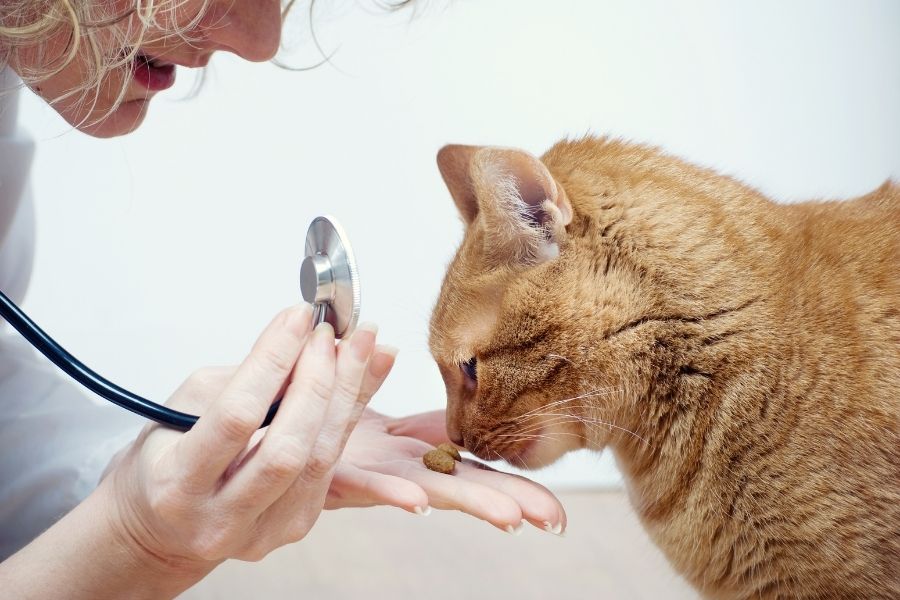
We already know that cats feel anxious when they smell danger or a change lurking. Do you think they don’t realise that you are taking them for a vaccination, a medical check-up or an injection? Yes, it does and it gets stressed! That’s why we want to talk to you about how to manage your cat’s anxiety when you have to take it to the vet.
Firstly, we need to learn to recognise the signs of this emotional state. An anxious cat may experience increased heart and respiratory rate, shortness of breath, trembling and increased salivation. If it senses imminent danger, it will tend to move more than usual, hide and vocalise more often.
It is important to keep in mind that many fears that cause stress develop because of traumatic experiences in the first year of life and therefore it is very important to prevent uncomfortable situations during the first visit to the vet.
Vet stress
No wonder a cat is afraid of the vet!
The truth is that everyone is afraid of new people and changes of environment: it is a kind of primordial survival instinct.
From its point of view, this experience means a forced imprisonment in a box (the carrier) that leads it inside a noisy machine that emits terrifying sounds (the car) and moves very fast, making it nauseous. Finally, it arrives in an unfamiliar environment where it encounters new smells and some dogs.
If the first experience of being away from home is this traumatic, it will mark it with stress every time it notices the first signs of an impending departure.
Signs of anxiety in cats
If your cat has entered a state of anxiety, it will change its usual behaviour and you may notice that:
- Avoids eye contact
- Heads away or runs away
- Tail tucked close to the body
- Its pupils are dilated
If it suffers from severe stress:
- Increased respiratory rate
- Attempts to run away or becomes immobile
- Raises hair
- Aggressive
Obviously if you chase it around the house and grab it from under the bed, inside the wardrobe or any other hiding place it has found, it will be a declaration of war that will influence your future travels.
How to manage your cat’s anxiety when you have to take it to the vet
- Try to get your cat used to the kennel at home
Start a week or two before the first visit to leave the carrier open and accessible in the most comfortable areas of the house. Most cats like to crawl into bags, under the bed or into boxes and will crawl into the carrier if they don’t associate it with the traumatic experience of being forced into a cage a few seconds before an unwanted trip. If you leave a tasty treat in the crate, it is easier for it to quickly become a desirable place.

- Get your cat used to the car too
Put a blanket around the carrier and carefully place it on the back seat of the car. Close the car door but don’t go far away. Do this at quiet times when there are no strange noises that might frighten your cat. Wait a few minutes and take your cat home. Do this for a few days at a time, gradually increasing the time in the car until you take it for a short trip around the block.
- Train your cat to be handled
Be patient and build up your cat’s tolerance to being touched. Keep sessions short and reward your cat with treats or games that it can use with you. Give your cat the cuddles it likes best, such as stroking under the chin. You can also try bathing it at home, using our specific Cat Line products and turning the bath into a special pampering session.

- Find a vet who is not far from where you live.
It may seem like overkill; you’ve probably known your vet for years and don’t intend to change even if you live across town. Just know that it will be the same vet who will advise against long journeys.
- Home visits
If nothing works, many vets offer a home visit service. This is a way to take the stress out of travelling and the stress of the kennel. It will also help reduce the time your cat spends in the studio or in contact with other cats or dogs.
Finally…
Even the most compliant and affectionate cats feel stress and fear in a way that we can’t understand.
They all deserve special attention when asked to do something out of their routine. If you have chosen a cat as a pet, you already know that they are dominant. Become its faithful servant and give it the attention he deserves.



